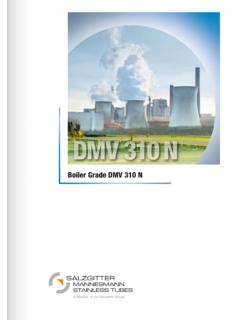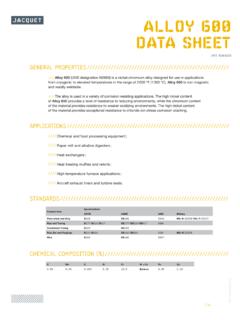Transcription of Standard Test Methods for Tensile, Compressive, …
1 Designation: D 2990 01 Standard Test Methods forTensile, compressive , and flexural creep and creep - rupture of Plastics1 This Standard is issued under the fixed designation D 2990; the number immediately following the designation indicates the year oforiginal adoption or, in the case of revision, the year of last revision. A number in parentheses indicates the year of last reapproval. Asuperscript epsilon (e) indicates an editorial change since the last revision or Standard has been approved for use by agencies of the Department of Scope * These test Methods cover the determination of tensileand compressive creep and creep - rupture of plastics underspecified environmental conditions (see ). While these test Methods outline the use of three-pointloading for measurement of creep in flexure, four-point loading(which is used less frequently) can also be used with theequipment and principles as outlined in Test Methods D For measurements of creep - rupture , tension is the pre-ferred stress mode because for some ductile plastics rupturedoes not occur in flexure or Test data obtained by these test Methods are relevant andappropriate for use in engineering The values stated in SI units are to be regarded as thestandard.
2 The values in parentheses are for information Standard does not purport to address all of thesafety concerns, if any, associated with its use. It is theresponsibility of the user of this Standard to establish appro-priate safety and health practices and determine the applica-bility of regulatory limitations prior to specific warningstatement is given in This Standard and ISO 899 are similar in content, but are Referenced Standards:D 543 Practices for Evaluating the Resistance of Plastics toChemical Reagents2D 618 Practice for Conditioning Plastics for Testing2D 621 Test Methods for Deformation of Plastics UnderLoad3D 638 Test Method for tensile Properties of Plastics2D 695 Test Method for compressive Properties of RigidPlastics2D 790 Test Methods for flexural Properties of Unreinforcedand Reinforced Plastics and Electrical Insulating Materi-als2D 1822 Test Method for tensile -Impact Energy to BreakPlastics and Electrical Insulating Materials2D 2236 Test Method for Dynamic Mechanical Properties ofPlastics by Means of a Torsional Pendulum4D 4000 Classification System for Specifying Plastic Mate-rials5D 4968 Guide for Annual Review of Test Methods andSpecifications
3 For Plastics63. of Terms Specific to This modulus the ratio of initial applied stress tocreep strain the total strain, at any given time,produced by the applied stress during a creep The term creep , as used in this testmethod, reflects current plastics engineering usage. In scientificpractice, creep is often defined to be the nonelastic portion ofstrain. However, this definition is not applicable to existingengineering formulas. Plastics have a wide spectrum of retar-dation times, and elastic portions of strain cannot be separatedin practice from nonelastic. Therefore, wherever strain ismentioned in these test Methods , it refers to the sum of elasticstrain plus the additional strain with a change in shape, size or position of atest specimen as a result of compression, deflection, or exten- in a compressive creep test, the de-crease in length produced in the gage length of a test in a flexural creep test, the change inmid-span position of a test in a tensile creep test, the increase inlength produced in the gage length of a test ratio the ratio of the length of a columnof uniform cross section to its least radius of gyration.
4 For1 These test Methods are under the jurisdiction of ASTM Committee D20 onPlastics and are the direct responsibility of Subcommittee on edition approved August 10, 2001. Published October 2001. Originallypublished as D 2990 71. Last previous edition D 2990 95. These test methodsand Practice D 2991 replace Practices D 674, which has been Book of ASTM Standards, Vol ; see1994 Annual Book of ASTM Standards, Vol , see1984 Annual Book of ASTM Standards, Vol Book of ASTM Standards, Vol Book of ASTM Standards, Vol *A Summary of Changes section appears at the end of this ASTM International, 100 Barr Harbor Drive, PO Box C700, West Conshohocken, PA 19428-2959, United of uniform rectangular cross section, the radius ofgyration is times the smaller cross-sectional dimension;for specimens of uniform circular cross section, the radius ofgyration is times the for tensile or compressive creep , the ratio ofthe applied load to the initial cross-sectional area.
5 For flexuralcreep, maximum fiber stress is as calculated in accordance withTest Methods D Summary of Test These test Methods consist of measuring the extensionor compression as a function of time and time-to- rupture , orfailure of a specimen subject to constant tensile or compressiveload under specified environmental Significance and Data from creep and creep - rupture tests are necessary topredict the creep modulus and strength of materials underlong-term loads and to predict dimensional changes that mayoccur as a result of such Data from these test Methods can be used: (1)tocompare materials, (2) in the design of fabricated parts, (3)tocharacterize plastics for long-term performance under constantload, and (4) under certain conditions, for Before proceeding with this test method, referenceshould be made to the specification of the material being specimen preparation, conditioning, dimensions, and/ortesting parameters covered in the material specification shalltake precedence over those mentioned in this test method,except in cases where to do so would conflict with the purposefor conducting testing.
6 If there are no material specifications,then the default conditions The grips and gripping technique shall bedesigned to minimize eccentric loading of the or universal joints shall be used beyond each end of It is recommended that grips permit the final centeringof the specimen prior to applying the load. Grips that permit adisplacement of the specimen within the grips during loadapplication are not Parallel anvils shall be used to apply the loadto the unconfined-type specimen (see ). One of the anvils ofthe machine shall preferably be self-aligning and shall, in orderthat the load may be applied evenly over the face of thespecimen, be arranged so that the specimen is accuratelycentered and the resultant of the load is through its arrangements are shown in Fig.
7 1 and Fig. 2 of TestMethods D Tube A guide tube and fixtures shall be usedwhen testing slender specimens (see ) to prevent suitable arrangement is shown in Fig. 1. The guide tube is ( ) Schedule 40 stainless steel pipe nippleapproximately 150 mm (6 in.) long reamed to ( ) inside Rack A rigid test rack shall be used to providesupport of the specimen at both ends with a span equal to 16 FIG. 1 A compressive creep Apparatus Including Details When Used in an Environmental ChamberD2990 012( + 4, 2) times the thickness of the specimen. In order toavoid excessive indentation of the specimen, the radius of thesupport shall be mm ( in). Sufficient space must beallowed below the specimen for dead-weight loading at A stirrup shall be used which fits over thetest specimen from which the desired load may be suspendedto provide flexural loading at mid-span.
8 In order to preventexcessive indentation or failure due to stress concentrationunder the stirrup, the radius of the stirrup shall be mm( in.). Connection between stirrup and weight shall bemade in a manner to avoid nonuniform loading caused bymisalignment or rack not being A suitable arrangement is shown in Fig. System The loading system must be so de-signed that the load applied and maintained on the specimen iswithin61 % of the desired load. The loading mechanism mustallow reproductively rapid and smooth loading as specified In creep - rupture tests , provision must be made to ensurethat shock loading, caused by a specimen failure, is nottransferred to other specimens undergoing Loading systems that provide a mechanical advantagerequire careful design to maintain constant load throughout thetest.
9 For example, lever systems must be designed so that theload does not change as the lever arm moves during the , Compression, and Deflection The extension or compression of specimen gagelength under load shall be measured by means of any devicethat will not influence the specimen behavior by mechanical(undesirable deformation, notches, etc.), physical (heating ofspecimen, etc.), or chemical effects. Preferably the extensionshall be measured directly on the specimen, rather than by gripseparation. Anvil displacement may be used to measure com-pression. If extension measurements are made by grip separa-tion, suitable correction factors must be determined, so thatstrain within the gage length may be calculated. These correc-tion factors are dependent on the geometry of the specimen andits drawing behavior, and they must be measured with respectto these The deflection of the specimen at mid-span shall bemeasured using a dial gage (with loading springs removed,with its measuring foot resting on stirrup) or a The accuracy of the deformation measuring deviceshall be within61 % of the deformation to be Deformation measuring devices shall be calibratedagainst a precision micrometer screw or other suitable standardFIG.
10 2 flexural creep Test ApparatusD2990 013under conditions as nearly identical as possible with thoseencountered in the test. Caution is necessary when usingdeformation measuring devices whose calibration is subject todrifting with time and is dependent on temperature Deformation measuring devices shall be firmly at-tached to or seated on the specimen so that no slippage resistance gages are suitable only if the materialtested will permit perfect adhesion to the specimen and if theyare consistent with Measurement The accuracy of the time measur-ing device shall be61 % of the time-to- rupture or failure orthe elapsed time of each creep measurement, or Control and The temperature of the test space, especially close tothe gage length of the specimen.



